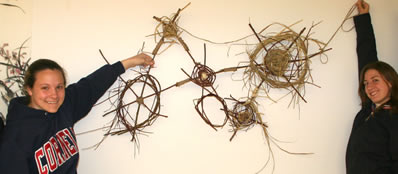
Two students hold up a fanciful, 2-dimensional
wall hanging they produced in a couple of hours
Activity,
step by step
This project is a terrific way to stretch our understanding
of “art,” as functional or decorative,
with a diversity of plant materials. Begin by gathering
as much plant material as you possibly can –
the more diverse, and the larger material, the more
you can create.
First,
demonstrate the proper way to use pruning shears.
Encourage
young people to work in teams to look over the material,
and plan what they may want to make. Encourage them
to be inspired by what they see – what kinds
of things could be made with the materials at hand?
Remember
the “haircut rule” – you cannot
make a stem longer after it’s been cut, so err
on the side of fewer initial cuts.
At
first, they may look for guidance. You can provide
it, or you can simply encourage them to use their
imagination to come up with “something.”
Be prepared for a period of time in which there is
a bit of tension, as the young people discuss what
they could do.
 Printable
PDF version
Printable
PDF version